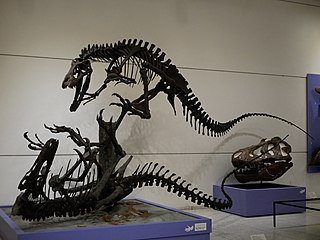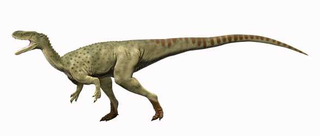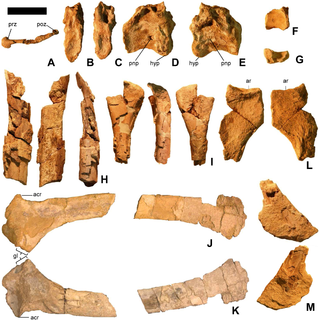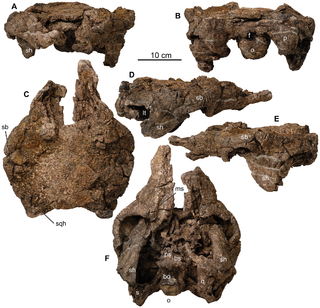
Torvosaurus is a genus of large megalosaurine theropod dinosaur that lived approximately 165 to 148 million years ago during the Callovian to Tithonian ages of the late Middle and Late Jurassic period in what is now Colorado, Portugal, Germany, and possibly England, Spain, Tanzania, and Uruguay. It contains two currently recognized species, Torvosaurus tanneri and Torvosaurus gurneyi, plus a third unnamed species from Germany.

Yangchuanosaurus is an extinct genus of metriacanthosaurid theropod dinosaur that lived in China from the Middle Jurassic to Late Jurassic periods, and was similar in size and appearance to its North American and European relative, Allosaurus. Yangchuanosaurus hails from the Upper Shaximiao Formation and was the largest predator in a landscape that included the sauropods Mamenchisaurus and Omeisaurus and the stegosaurs Chialingosaurus, Tuojiangosaurus and Chungkingosaurus. This theropod was named after the area in which was discovered, Yongchuan, in China.

Masiakasaurus is a genus of small predatory noasaurid theropod dinosaurs from the Late Cretaceous of Madagascar. In Malagasy, masiaka means "vicious"; thus, the genus name means "vicious lizard". The type species, Masiakasaurus knopfleri, was named after the musician Mark Knopfler, whose music inspired the expedition crew. It was named in 2001 by Scott D. Sampson, Matthew Carrano, and Catherine A. Forster. Unlike most theropods, the front teeth of M. knopfleri projected forward instead of straight down. This unique dentition suggests that they had a specialized diet, perhaps including fish and other small prey. Other bones of the skeleton indicate that Masiakasaurus were bipedal, with much shorter forelimbs than hindlimbs. M. knopfleri was a small theropod, reaching 1.8–2.1 m (5.9–6.9 ft) long and weighing 20 kg (44 lb).

Alectrosaurus is a genus of tyrannosauroid theropod dinosaur that lived in Asia during the Late Cretaceous period, about some 96 million years ago in what is now the Iren Dabasu Formation.

Adasaurus is a genus of dromaeosaurid dinosaur that lived in Asia during the Late Cretaceous period about 70 million years ago. The genus is known from two partial specimens found in the Nemegt Formation of Mongolia that were partially described in 1983 by the paleontologist Rinchen Barsbold.

Elaphrosaurus is a genus of ceratosaurian theropod dinosaur that lived approximately 154 to 150 million years ago during the Late Jurassic Period in what is now Tanzania in Africa. Elaphrosaurus was a medium-sized but lightly built member of the group that could grow up to 6.2 m (20 ft) long. Morphologically, this dinosaur is significant in two ways. Firstly, it has a relatively long body but is very shallow-chested for a theropod of its size. Secondly, it has very short hindlimbs in comparison with its body. Phylogenetic analyses indicate that this genus is likely a ceratosaur. Earlier suggestions that it is a late surviving coelophysoid have been examined but generally dismissed. Elaphrosaurus is currently believed to be a very close relative of Limusaurus, an unusual beaked ceratosaurian which may have been either herbivorous or omnivorous.

Dryptosaurus is a genus of basal eutyrannosaurian theropod dinosaur that lived on the island continent of Appalachia approximately 67.6 million years ago during the end of the Maastrichtian age of the Late Cretaceous period. Dryptosaurus was a large, bipedal, ground-dwelling carnivore that could grow up to 7.5 metres (25 ft) long and weigh up to 756–1,500 kilograms (1,667–3,307 lb). Although it is now largely unknown outside of academic circles, the famous 1897 painting of the genus by Charles R. Knight made Dryptosaurus one of the more widely known dinosaurs of its time, in spite of its poor fossil record. First described by Edward Drinker Cope in 1866 and later renamed by Othniel Charles Marsh in 1877, Dryptosaurus is among the first theropod dinosaurs ever known to science.

Chindesaurus is an extinct genus of basal saurischian dinosaur from the Late Triassic of the southwestern United States. It is known from a single species, C. bryansmalli, based on a partial skeleton recovered from Petrified Forest National Park in Arizona. The original specimen was nicknamed "Gertie", and generated much publicity for the park upon its discovery in 1984 and airlift out of the park in 1985. Other fragmentary referred specimens have been found in Late Triassic sediments throughout Arizona, New Mexico, and Texas, but these may not belong to the genus. Chindesaurus was a bipedal carnivore, approximately as large as a wolf.

Sinovenator is a genus of troodontid dinosaur from China. It is from the early Cretaceous Period.

Spinostropheus is a genus of carnivorous neotheropod theropod dinosaur that lived in the Middle Jurassic period and has been found in the Tiouraren Formation, Niger. The type and only species is S. gautieri.

Wiehenvenator is a genus of megalosaurid theropod dinosaur from the Middle Jurassic (Callovian) of north western Germany. The genus contains a single species, W. albati.

Martharaptor is a genus of therizinosauroid theropod dinosaurs from the Early Cretaceous of the Cedar Mountain Formation in Utah. They can be distinguished from other therizinosauroids by means of several features of the skeleton which were intermediate between early therizinosaurs such as Falcarius and Beipiaosaurus, and more "advanced" members of the group like therizinosaurids. The deep and homogeneous hand claws clearly differ from the case in early therizinosauroids, but the foot has not yet acquired the robust morphology of therizinosaurids.

Europelta is a monospecific genus of nodosaurid dinosaur from Spain that lived during the Early Cretaceous in what is now the lower Escucha Formation of the Teruel Province. The type and only species, Europelta carbonensis, is known from two associated partial skeletons, and represents the most complete ankylosaur known from Europe. Europelta was named in 2013 by James I. Kirkland and colleagues. Europelta has an estimated length of 5 metres and weight of 1.3 tonnes, making it the largest member of the clade Struthiosaurini.
Panguraptor is a genus of coelophysid theropod dinosaur known from fossils discovered in Lower Jurassic rocks of southern China. The type and only known species is Panguraptor lufengensis. The generic name refers to the deity Pangu but also to the supercontinent Pangaea for which in a geological context the same characters are used: 盘古. Raptor means "seizer", "robber" in Latin. The specific name is a reference to the Lufeng Formation. The holotype specimen was recovered on 12 October 2007 from the Lufeng Formation of Yunnan, which is noted for sauropodomorph fossils. It was described in 2014 by You Hai-Lu and colleagues.

Lingwulong is a genus of dicraeosaurid sauropod dinosaur from the Middle Jurassic of what is now Lingwu, Yinchuan, Ningxia, China. The type and only species is L. shenqi, known from several partial skeletons. It is the earliest-aged neosauropod ever discovered, as well as the only definite diplodocoid from east Asia.
Siamraptor is an extinct genus of likely carcharodontosaurian dinosaur, containing the single species S. suwati, known from the Khok Kruat Formation of Thailand. It is possibly the first definitive named carcharodontosaurian species known from Southeast Asia. However a later 2024 study found it to be an early tetanuran outside of the group Orionides, although the describers of Alpkarakush still found it within the Carcharodontosauria the same year.

Asfaltovenator is a genus of possibly allosauroid dinosaur from the Lower Jurassic Cañadón Asfalto Formation of Chubut Province, Argentina. The type and only species is Asfaltovenator vialidadi.

Paraxenisaurus is an extinct genus of ornithomimosaurian theropod from the Late Cretaceous Cerro del Pueblo Formation of Coahuila in Mexico. The genus contains a single species, P. normalensis, which is known from a few bones of tail, hips, hands, and feet. The specific epithet was given in honor of the Benemérita Normal School of Coahuila, a teacher training institution, where the fossils were reposited. It is a member of the family Deinocheiridae and is the only member of that clade known from Laramidia.

IberospinusIPA:[aɪbiːʌroʊs̠piːnʊs̠] or IPA:[aɪbiːʌroʊs̠paɪnʌs̠] is an extinct genus of spinosaurid dinosaur from the Early Cretaceous (Barremian) Papo Seco Formation of Portugal. The genus contains a single species, I. natarioi, known from several assorted bones belonging to one individual. Iberospinus represents one of five known spinosaurid taxa from the Iberian Peninsula, the others being Camarillasaurus, Protathlitis, Riojavenatrix, and Vallibonavenatrix. It is important for its implications of the geographical origin of Spinosauridae and the suggested presence of potentially semi-aquatic lifestyle earlier in the evolution of this clade.

Garumbatitan is an extinct genus of somphospondylan sauropod dinosaur from the Cretaceous Arcillas de Morella Formation of Spain. The genus contains a single species, G. morellensis, known from multiple partial skeletons.



































